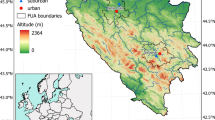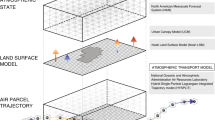Abstract
Field observations of air and surface temperatures, relative humidity, solar radiation and wind were performed in the daytime hours of the warm season around a pond of 4 ha, located in Begin Park, in the city of Tel Aviv, Israel. Observations were carried out at screened meteorological stations on four randomly selected days, all associated with moderate heat stress. Two of them, one representing a warm and dry day, and other, representing a sultry day, are analyzed in detail. At the downwind side of the pond, lower temperatures, a higher relative humidity and a lower heat stress index were observed consistently when compared with stations located upwind of the pond. This effect is regarded here as the "lake effect". The fact that no significant change was noted in the water vapor pressure during most of the daytime hours indicates that the lake effect was related mainly to cooling rather than to moisture transport from the pond. A positive relationship was found between the lake effect and wind speed in both types of weather. The maximum effect of the wind's speed on the lake effect was observed at midday, at which time the temperature drop reached 1.6 °C, while the relative humidity rose by 6%. As a result, the heat stress index dropped by 0.8–1.1 °C. It is suggested that the temperature drop induced by the pond during the warmest hours of the day was mainly the result of a truncation of the sensible heat flux from the underlying surface when the air, which had previously passed over hot surfaces, swept over the relatively cool water. During the late afternoon and evening hours, when the water became warmer than the surrounding surfaces, latent heat cooling resulting from evaporation became the dominant source of the lake effect, and the lake effect resulted in increasing heat stress. It is concluded that even small bodies of water have a relieving effect on humans in the daytime hours, within the range of 40 m, under both dry and humid hot weather conditions.









Similar content being viewed by others
References
Air Ministry Meteorological Office (1962) Weather in the Mediterranean, vol 1. Meteorological office, London
Alpert P, Ziv B (1989) The Sharav observation and some theoretical considerations. J Geophys Res 94: 18,495–18,514
Alpert P, Abramski R, Neeman BU (1992) The prevailing summer synoptic system in Israel. Subtropical high, not Persian trough. Isr J Earth Sci 39: 93–102
Arya SP (2001) Introduction to micrometeorology. Academic Press, San Diego
Barradas VL (1991) Air temperature and humidity and human comfort index of some city parks of Mexico City. Int J Biometeorol 35: 24–28
Bitan A, Saaroni H (1992) The horizontal and vertical extension of the Persian Gulf trough. Int J Climatol 12: 733–747
Bitan A, Rubin S (1994) Climatic atlas of Israel for physical and environmental planning and design. Ramot, Tel Aviv
Doron E (1979) Objective analysis of mesoscale flow fields in Israel and trajectory calculations. Isr J Earth Sci 28: 33–41
Eliasson I (1996) Urban nocturnal temperatures, street geometry and land use. Atmos Environ 30: 379–392
Givoni B (1991) Impact of planted areas on urban environmental quality: a review. Atmos Environ B 25: 289–299
Grimmond CSB, Souch C, Hubble MD (1996) Influence of tree cover on summertime surface energy balanced fluxes, San Gabriel Valley, Los Angeles. Clim Res 6: 45–57
Israel Meteorological Service (1983) Climatological standard normals of temperature and relative humidity 1964–1979. Series A, no 41. Bet Dagan
Jauregui E (1990/91) Influence of a large park of temperature and convective precipitation in a tropical city. Energy Build 15/16: 457–463
Naot O, Mahrer Y (1991) Two-dimensional microclimate distribution within and above a crop canopy in an arid environment: modelling and observational studies. Boundary-Layer Meteorol 56: 223–244
Oke TR (1989) The micrometeoroogy of the urban forest. Philos Trans R Soc London [Biol] 324: 335–349
Saaroni H, Ziv B (2000) Summer rainfall in a Mediterranean climate: the case of Israel. Climatological – dynamic analysis. Int J Climatol 20: 191–209
Segal M, Mahrer Y, Pielke RA (1982) Numerical study of wind energy characteristics over heterogeneous terrain – central Israel case study. Boundary Layer Meteorol 53: 333–351
Skibin D, Hod A (1979) Subjective analysis of mesoscale flow patterns in Northern Israel. J Appl Meteorol 18: 329–338
Sohar E (1980) Determination and presentation of heat load in physiologically and meaningful terms. Int J Bioclimatol Ser B 14: 336–359
Sproken-Smith RA, Oke TR (1998) The thermal regime of urban parks in two cities with different summer climates. Int J Remote Sensing 19: 3039–3053
Sutton OG (1953) Micrometeorology. McGraw-Hill, New York, pp 229–230
Tanner CB (1968) Evaporation of water from plants and soil. In: Kozlowski TT (ed) Water deficits and plant growth, vol 1. Academic Press, New York, p 92
Thom EC (1959) The discomfort index. Weatherwise 12: 57–60
Acknowledgements
This study was supported by the Israelli Science Foundation (grant 828/02). Special thanks are due to Orna Zafrir-Reuven from the Cartographic Laboratory at the Geography Department, Tel Aviv University, for her assitance in the preparation of the figures.
Author information
Authors and Affiliations
Corresponding author
Appendix
Appendix
Dependence of heat stress index on dry temperature
Following Tanner (1968) the wet bulb temperature (T w) is given by:
where e and e* are water vapour pressure and saturation water vapor pressure, respectively, s is ∂e*/∂T and γ is the psychrometer constant (positive). Since the saturation water vapor pressure can be written as
where both A and B are positive constants, then
Inserting Eqs. 3 and 5 in Eq. 1 yields
Assuming that e is constant, i.e., there is no addition or subtraction of moisture to the air, the dependence of HSI on T is obtained by differentiating with respect to T, yielding, after some algebraic manipulations:
Since both B, e* and γ are positive, the numerical value of the second term in the right-hand side of Eq. 7 is smaller than unity, so the derivative is positive, implying that when the water vapour pressure of an air mass remains unchanged and its temperature decreases, the heat stress decreases as well.
Rights and permissions
About this article
Cite this article
Saaroni, H., Ziv, B. The impact of a small lake on heat stress in a Mediterranean urban park: the case of Tel Aviv, Israel. Int J Biometeorol 47, 156–165 (2003). https://doi.org/10.1007/s00484-003-0161-7
Received:
Revised:
Accepted:
Published:
Issue Date:
DOI: https://doi.org/10.1007/s00484-003-0161-7




